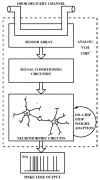An Investigation into Spike-Based Neuromorphic Approaches for Artificial Olfactory Systems
- PMID: 29125586
- PMCID: PMC5713038
- DOI: 10.3390/s17112591
An Investigation into Spike-Based Neuromorphic Approaches for Artificial Olfactory Systems
Abstract
The implementation of neuromorphic methods has delivered promising results for vision and auditory sensors. These methods focus on mimicking the neuro-biological architecture to generate and process spike-based information with minimal power consumption. With increasing interest in developing low-power and robust chemical sensors, the application of neuromorphic engineering concepts for electronic noses has provided an impetus for research focusing on improving these instruments. While conventional e-noses apply computationally expensive and power-consuming data-processing strategies, neuromorphic olfactory sensors implement the biological olfaction principles found in humans and insects to simplify the handling of multivariate sensory data by generating and processing spike-based information. Over the last decade, research on neuromorphic olfaction has established the capability of these sensors to tackle problems that plague the current e-nose implementations such as drift, response time, portability, power consumption and size. This article brings together the key contributions in neuromorphic olfaction and identifies future research directions to develop near-real-time olfactory sensors that can be implemented for a range of applications such as biosecurity and environmental monitoring. Furthermore, we aim to expose the computational parallels between neuromorphic olfaction and gustation for future research focusing on the correlation of these senses.
Keywords: biomimetic sensors; electronic nose; neuromorphic olfaction.
Conflict of interest statement
The authors declare no conflict of interest.
Figures
Similar articles
-
Application of Neuromorphic Olfactory Approach for High-Accuracy Classification of Malts.Sensors (Basel). 2022 Jan 7;22(2):440. doi: 10.3390/s22020440. Sensors (Basel). 2022. PMID: 35062402 Free PMC article.
-
Artificial Olfactory Neuron for an In-Sensor Neuromorphic Nose.Adv Sci (Weinh). 2022 Jun;9(18):e2106017. doi: 10.1002/advs.202106017. Epub 2022 Apr 15. Adv Sci (Weinh). 2022. PMID: 35426489 Free PMC article.
-
A Review of Current Neuromorphic Approaches for Vision, Auditory, and Olfactory Sensors.Front Neurosci. 2016 Mar 29;10:115. doi: 10.3389/fnins.2016.00115. eCollection 2016. Front Neurosci. 2016. PMID: 27065784 Free PMC article. Review.
-
The Synthetic Moth: A Neuromorphic Approach toward Artificial Olfaction in Robots.In: Persaud KC, Marco S, Gutiérrez-Gálvez A, editors. Neuromorphic Olfaction. Boca Raton (FL): CRC Press/Taylor & Francis; 2013. Chapter 4. In: Persaud KC, Marco S, Gutiérrez-Gálvez A, editors. Neuromorphic Olfaction. Boca Raton (FL): CRC Press/Taylor & Francis; 2013. Chapter 4. PMID: 26042327 Free Books & Documents. Review.
-
Real-Time Classification of Multivariate Olfaction Data Using Spiking Neural Networks.Sensors (Basel). 2019 Apr 18;19(8):1841. doi: 10.3390/s19081841. Sensors (Basel). 2019. PMID: 31003417 Free PMC article.
Cited by
-
Event-Based Sensing and Signal Processing in the Visual, Auditory, and Olfactory Domain: A Review.Front Neural Circuits. 2021 May 31;15:610446. doi: 10.3389/fncir.2021.610446. eCollection 2021. Front Neural Circuits. 2021. PMID: 34135736 Free PMC article. Review.
-
Application of Neuromorphic Olfactory Approach for High-Accuracy Classification of Malts.Sensors (Basel). 2022 Jan 7;22(2):440. doi: 10.3390/s22020440. Sensors (Basel). 2022. PMID: 35062402 Free PMC article.
-
Artificial Olfactory Neuron for an In-Sensor Neuromorphic Nose.Adv Sci (Weinh). 2022 Jun;9(18):e2106017. doi: 10.1002/advs.202106017. Epub 2022 Apr 15. Adv Sci (Weinh). 2022. PMID: 35426489 Free PMC article.
-
Autonomous Flying With Neuromorphic Sensing.Front Neurosci. 2021 May 14;15:672161. doi: 10.3389/fnins.2021.672161. eCollection 2021. Front Neurosci. 2021. PMID: 34054420 Free PMC article.
-
A Hardware-Deployable Neuromorphic Solution for Encoding and Classification of Electronic Nose Data.Sensors (Basel). 2019 Nov 6;19(22):4831. doi: 10.3390/s19224831. Sensors (Basel). 2019. PMID: 31698785 Free PMC article.
References
-
- Gardner J.W., Bartlett P.N. A brief history of electronic noses. Sens. Actuators B Chem. 1994;18:210–211. doi: 10.1016/0925-4005(94)87085-3. - DOI
-
- Moncrieff R. An instrument for measuring and classifying odors. J. Appl. Physiol. 1961;16:742–749. - PubMed
-
- Gardner J., Cole M., Udrea F. Cmos gas sensors and smart devices; Proceedings of the 2002 IEEE Sensors; Orlando, FL, USA. 12–14 June 2002; pp. 721–726.
-
- James D., Scott S.M., Ali Z., O’Hare W.T. Chemical sensors for electronic nose systems. Microchim. Acta. 2005;149:1–17. doi: 10.1007/s00604-004-0291-6. - DOI
Publication types
MeSH terms
LinkOut - more resources
Full Text Sources
Other Literature Sources




